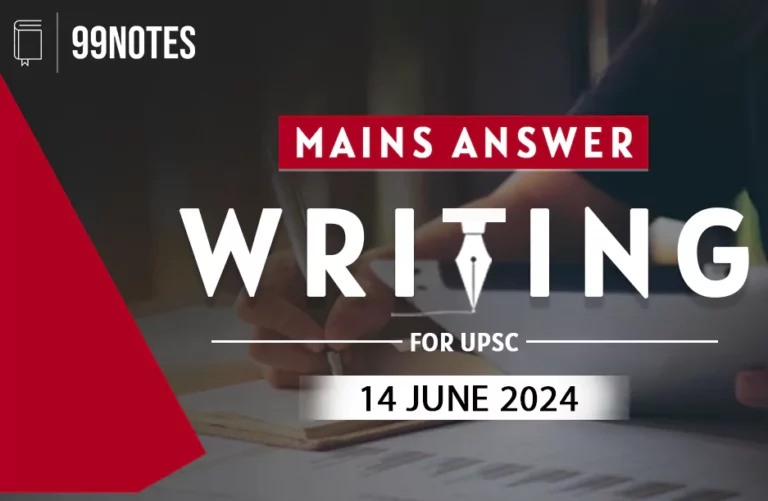18 January 2025 : Daily Current Affairs
1. Research questions ‘iron deficiency’ as key cause of anaemia in India
(Source – The Hindu, International Edition – Page No. – 5)
| Context |
|
Anaemia in Women and Adolescents
- Anaemia prevalence in women aged 15-49 was 41.1%, lower than the 60.8% recorded in the National Family Health Survey (NFHS-5).
- Among adolescent girls aged 15-19, 44.3% were anaemic, compared to 62.6% in NFHS-5.
Study Overview
- Researchers from institutions like St. John’s Medical College and the National Institute of Nutrition conducted the study.
- Published in the European Journal of Clinical Nutrition, the study tested 4,500 individuals across eight states.
Possible Causes of Anaemia
- In addition to iron deficiency, the study suggests other potential causes of anaemia, including:
- Vitamin B12 or folate deficiencies.
- Blood loss.
- Environmental factors such as air pollution.
Difference in Testing Methods
- The study used venous blood draws for testing, which may have led to lower estimates of anaemia compared to the NFHS, which used capillary blood (from a pinprick).
- This study provides valuable insights into anaemia prevalence and its potential causes, particularly among women and adolescents.
| Anaemia in India |
|
| Practice Question: Analyse the prevalence of anaemia in India, highlighting the key factors contributing to its high rates. Discuss the challenges faced in combating anaemia and suggest a way forward to address this public health issue. (250 Words /15 marks) |
2. UNICEF’s Prospects for Children in 2025 Report
| Topic: GS2 – Social Justice |
| Context |
|
Analysis of the news:
About UNICEF:
- The United Nations International Children’s Emergency Fund (UNICEF) was established in 1946, in the aftermath of World War II.
- Mandate: To help children and young people whose lives and futures were at risk – no matter what role their country had played in the war.
- It works in over 190 countries and territories to protect the rights of every child.
- Funding: UNICEF’s work is funded entirely through the voluntary support of millions of people around the world and our partners in government, civil society and the private sector.
- Awards: It has received the Nobel Peace Prize in 1965, the Indira Gandhi Prize in 1989, and the Princess of Asturias Award in 2006.
- It publishes important Reports: The State of the World’s Children, The State of the World’s Children reports.
- Global Initiatives:
- In 2012, UNICEF worked with Save the Children and The United Nations Global Compact to develop the Children’s Rights and Business Principles, and now these guidelines form the basis of UNICEF’s advice to companies.
- UNICEF’s Data Must Speak Initiative (DMS) helps countries unlock existing data to expand access to education and improve learning for all.
- Headquarters: It is headquartered in New York City.
Key Highlights of the UNICEF Report on Children’s Challenges
Impact of Conflict on Children
- In 2023, over 473 million children—one in six globally—lived in conflict zones, marking a rise from 10% in the 1990s to 19% today.
- These children face severe risks, including displacement, starvation, disease, and psychological trauma, highlighting the urgent need for protective interventions.
Debt Crisis and Its Impact on Children
- Nearly 400 million children live in countries struggling with heavy debt burdens, which restrict investments in essential sectors like education, healthcare, and social services.
- A 5% increase in external debt for low- and middle-income countries could slash education budgets by $12.8 billion.
- In several low-income nations, debt servicing far exceeds spending on health and education, leaving 1.8 billion children vulnerable to poverty and economic shocks.
Climate Change Impact
- Only 2.4% of global climate finance is allocated to child-responsive initiatives, weakening crucial social services such as healthcare and education.
- This underinvestment in children during climate crises underscores the need for targeted financing to protect their future.
Digital Inequality
- While Digital Public Infrastructure (DPI) is transforming service delivery, a digital divide persists.
- In high-income countries, most youth (15-24 years) have internet access, but in Africa, only 53% of youth are connected, with adolescent girls and children with disabilities particularly disadvantaged.
- Nine out of ten adolescent girls in low-income countries remain offline, limiting their opportunities.
Way Forward
- The report calls for increased financing for climate recovery, focusing on child-responsive healthcare, education, and psychological well-being during crises.
- It urges the creation of inclusive systems that prioritize children’s rights and the integration of child rights into digital initiatives to bridge inequality gaps.
| Constitutional Provisions for Child Protection in India |
|
| PYQ: With reference to the United Nations Convention on the Rights of the Child, consider the following: (2010) The Right to Development The Right to Expression The Right to Recreation Which of the above is/are the Rights of the child? (a) 1 only (b) 1 and 3 only (c) 2 and 3 only (d) 1, 2 and 3 Ans: (d) |
| Practice Question: Examine the challenges highlighted in the UNICEF report, and suggest policy measures to safeguard children’s rights and well-being globally. (150 Words /10 marks) |
Prelims Facts
1. Russia, Iran sign treaty to deepen ties in the face of Western curbs
(Source – The Hindu, International Edition – Page No. – 12)
| Context |
|
Key Objectives:
- Strengthen economic and trade relations, addressing technical obstacles for gas shipments and transport corridors.
- Enhance military and technological collaboration, particularly in response to Western sanctions.
- Foster regional stability through mutual cooperation, countering external interference (especially the U.S.).
Context and Necessity:
- Sanctions: Both Russia and Iran are facing severe Western sanctions, prompting the need for closer ties.
- Geopolitical Alignment: Russia and Iran share common interests in countering U.S. influence in the region, particularly in West Asia.
- Past Cooperation: Historical ties include nuclear energy projects and mutual support in Syria and Ukraine.
Significance:
- The treaty is seen as a strategic move to secure economic and military support amid growing external pressures, especially from the U.S.
2. Rights situation is ‘worsening’ in Central Asia: HRW
(Source – The Hindu, International Edition – Page No. – 13)
| Context |
|
Human Rights Watch:
- Human Rights Watch is an independent, international organization that works to defend human rights around the world.
- It was founded in 1978 and is headquartered in New York City.
- The organization conducts research and advocacy on human rights issues, exposing abuses and pressuring those in power to respect human rights.
- Human Rights Watch works on behalf of a wide range of people whose rights are violated, including refugees, children, migrants, and political prisoners.
- It publishes reports and briefings on human rights conditions in some 70 countries each year.
- Human Rights Watch advocates for policies to prevent human rights abuses and regularly meets with government officials and international organizations to press for change.
- The organization is a founding member of the International Freedom of Expression Exchange and co-chair of the International Campaign to Ban Landmines.
3. Role of sun in Spadex success
(Source – Indian Express, Section – Express Network- Page No. – 07)
| Context |
|
Analysis of the news:
India’s Space Docking Milestone
- India successfully achieved satellite docking for the first time through its Space Docking Experiment (SpaDeX), becoming the fourth nation to accomplish this challenging feat after the US, Russia, and China.
- On December 30, ISRO launched two satellites, SDX01 (Chaser) and SDX02 (Target), into low-Earth orbit.
- The Chaser gradually approached the Target over a series of precision maneuvers before the final docking.
Significance of Docking for Future Missions
- Docking is a critical capability for ambitious space projects like Chandrayaan-4 and the development of the Bharatiya Antariksha Station, where multiple components will need to be docked in space.
- It requires exceptional precision to align and connect docking ports at negligible relative velocity, ensuring no collisions or damage.
Role of Solar Activity
- Favorable solar activity played a pivotal role in SpaDeX’s success. Strong solar flares, coronal mass ejections, or high-speed solar wind streams can disrupt sensors, electronic systems, and communication, making docking extremely challenging.
- However, leading up to the SpaDeX docking, solar conditions were unusually calm despite the ongoing peak phase of Solar Cycle 25, which has generally been characterized by intense solar activity.
Challenges Posed by Space Weather
- Adverse space weather conditions, such as high-energy radiation and magnetic storms, can interfere with mission-critical systems, causing positional errors and communication loss.
- Such disruptions are particularly hazardous during docking maneuvers, which demand high precision.
Need for Space Weather Forecasting
- The SpaDeX success highlights the importance of reliable space weather forecasting. Improved real-time assessments of solar activity can help mitigate risks during critical space operations.
- Investments in space weather monitoring and forecasting are as vital as terrestrial weather forecasts to ensure the safety of infrastructure and mission success during periods of heightened solar activity.
The Sun’s Role in SpaDeX
- Despite the ongoing solar maximum phase, the Sun displayed fewer sunspots and calmer conditions in the days leading to SpaDeX docking, contributing significantly to the mission’s success.
- This underscores the collaborative necessity between precise engineering and favorable space weather for future advancements in space exploration.
3. India’s first private satellite constellation by PixxelSpace showcases the exceptional talent of India’s youth: PM
(Source – https://pib.gov.in/PressReleseDetail.aspx?PRID=2093878®=3&lang=1 )
| Context |
|
Launch of satellite constellation by PixxelSpace:
- PixxelSpace, an Indian space-tech startup, successfully launched the first three satellites of its “Firefly” constellation on January 14, 2025, from Vandenberg Space Force Base in California.
- These satellites are the world’s highest-resolution commercial hyperspectral imaging satellites, capable of capturing data in over 150 bands.
- This technology allows for detailed analysis of the Earth’s surface, providing valuable insights for various sectors, including agriculture, mining, and environmental monitoring.
- Pixxel plans to launch three more Firefly satellites in 2025, completing the first phase of its constellation and enabling near real-time global coverage.
- This achievement marks a significant milestone for India’s private space industry and its contribution to global Earth observation capabilities.
4. Lokpal of India celebrates 1st Foundation Day on 16th January
(Source – https://pib.gov.in/PressReleseDetail.aspx?PRID=2093664®=3&lang=1 )
| Context |
|
Introduction:
- The Lokpal of India is an anti-corruption ombudsman established to investigate and prosecute corruption cases against public officials.
Establishment:
- The Lokpal and Lokayuktas Act was passed in 2013 after a long struggle by anti-corruption activists.
- The Lokpal institution was finally established in March 2019.
Composition:
- It is comprised of a Chairperson and a maximum of eight members.
- The Chairperson should be either a former Chief Justice of India or a former Supreme Court judge.
Jurisdiction:
- The Lokpal has jurisdiction over a wide range of public functionaries, including the Prime Minister, Ministers, Members of Parliament, and Group A, B, C, and D officials of the Central Government.
Powers:
- The Lokpal has the power to initiate investigations, conduct inquiries, and file cases in special courts against public servants accused of corruption.
- It can also recommend disciplinary action against corrupt officials.
Limitations:
- The Lokpal’s jurisdiction does not extend to the armed forces, judiciary, and intelligence agencies.
- It cannot inquire into complaints against the Prime Minister related to international relations, external and internal security, public order, atomic energy, and space.
Conclusion
- The Lokpal is an important institution in India’s fight against corruption, providing a much-needed mechanism for holding public officials accountable.
| Practice Question: Despite the establishment of the Lokpal in India, corruption remains a persistent challenge. Critically analyze the limitations of the Lokpal in addressing corruption and suggest measures to enhance its effectiveness. (250 Words /15 marks) |
For more such UPSC related Current Affairs, Check Out- 17 January 2025 : Daily Current Affairs




